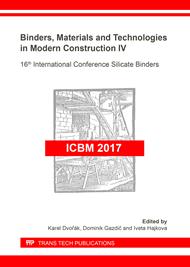p.185
p.192
p.198
p.204
p.210
p.217
p.223
p.229
p.236
Shaping Mortar Parameters in Terms of their Tendency to Form Shrinkage Cracks
Abstract:
The most common reason for the appearance of cracks or delamination of plaster is their too high strength - higher than the strength of the substrate, their low flexibility and high shrinkage during curing. The article presents a study on influences of natural and synthetic polymers with different chemical composition of the physical properties of category CS II mortars. Polymer additives in the form of dry powders were selected for testing. Studies were carried out in two versions: with constant consistence and with a constant w/c ratio maintained. It has been found that modifying mortars with synthetic polymers improves their flexibility and flexural tensile strength. The shrinkage is dependent on the ability of the synthetic polymer to liquefy fresh mortar where the tests were conducted maintaining constant consistence. Similar relationships were determined for cellulose ethers. Also in this case, the increase in the contents of the cellulose ethers increases their tensile strength and decreases the shrinkage. It was found that the impact of cellulose ethers on the shrinkage depends on their surface activity.
Info:
Periodical:
Pages:
210-216
Citation:
Online since:
June 2018
Authors:
Price:
Сopyright:
© 2018 Trans Tech Publications Ltd. All Rights Reserved
Share:
Citation:


